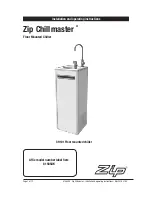
English
46/172
could cause severe damage to the user, people close
to the machine and the machine itself.
Always follow the safety rules given in this manual.
7.1. HOLDING AND GUIDING THE MACHINE
While working always place
yourself behind the machine
and hold it firmly with both
hands on the handles.
Warning! Do not use this rotary tiller with one
hand.
Warning! This rotary tiller could bounce upwards
or jump forwards unexpectedly. If the teeth hit
something hard that is buried in the ground such as
large stones, roots or trunks, if the soil is too hard or
if the ground is frozen. Always firmly hold the machine
with both hands.
This machine clutch is deactivated (disengaged)
by default, to activate the clutch and for the engine
power to transmit to milling cutters, the clutch lever
must be tightened.
Warning! The clutch lever has a safety lock to
prevent accidentally engaging the machine.
To activate the clutch you must first remove the safety
lock andwithout releasing the lock, tighten the clutch
lever.
7.2. WORKING WITH THE ROTARY TILLER
Start the machine following the instructions in the
manual.
Choose the appropriate speed of the gearbox for the
work to be undertaken:
- “SLOW” Slow speed is used to break the ground
(breaking and loosening the hardened ground) or
for cutting or burying the residues of the previous
crop.
- “FAST” Fast speed is used for secondary tillage
(last passes on land already carved just before
sowing).
Milling cutters in motion will pull the machine forward,
you must maintain the appropriate speed more or less
by nailing the spur in the soil.
Slowly move the tiller at the right rhythm so the milling
cutters have time go crumbling the land.
If the tiller sinks and doesn’t go, move the handlebar
left and right until it is released. When working on
slopes it is always slightly more above the slope so
that the machine is always below you.
7.2.1. USING SUGGESTIONS
A depth of tillage between 15-20 cm is generally
adequate, and rarely there is advantage in deeper. The
shallower tilling is frequently recommended for areas
of little rainfall to conserve moisture.
Secondary tillage is less shallow than the principal,
making 2 cross-styled passes on the terrain is
enough.
Содержание MULE 981 QG
Страница 57: ...Fran ais 57 172 NOTAS...
Страница 143: ...143 172 2 2 1 2 2 15...
Страница 144: ...144 172 2 2 1 2 2 2 Raynaud...
Страница 145: ...145 172 2 3 15 2 4...
Страница 146: ...146 172 2 5...
Страница 147: ...147 172 2 6...
Страница 148: ...148 172 3 0 6 20W 40 CE EU Lwa dB A XX...
Страница 149: ...149 172 4 ON ON OFF OFF HOT OIL ON ON OFF STOP...
Страница 150: ...150 172 5 2 1 2 3 4 5 6 7 8 9 10 11 12 13 14 15 16 17 18 ON OFF 19 5 5 1 4 15 5 14 13 3 6 1 7 9 8 10 11 16 2 12 19 17 18...
Страница 152: ...152 172 6 1 Pier 6 2 6 2 1 o t1 4 5 6 4 5 6 2 2 1 2 2 6 2 1 3 4 6 5 2 1 3...
Страница 153: ...153 172 6 2 3 1 2 6 2 4 1 2 6 3 1 2 3 4 1 2 3 3 1 2...
Страница 154: ...154 172 3 6 3 2 4 20w 40 0 6l 0 6l 1...
Страница 155: ...155 172 6 4 6 4 1 Garland 6 4 1 1 OFF 6 4 2 6 4 2 1 1 ON OFF ON 2 l 3 4 5...
Страница 156: ...156 172 6 7 8 9 6 4 2 2 1 ON OFF ON 2 l 3 3 6 7 6 4 2 3 1 2 O 3 6 4 3...
Страница 157: ...157 172 7 10 10 20 OFF 15...
Страница 158: ...158 172 7 1 2 7 2...
Страница 159: ...159 172 7 2 1 15 20 cm 2 8 8 1 8 1 1...
Страница 160: ...160 172 8 1 2 8 1 3 8 2...
Страница 161: ...161 172 25 50 100 300...
Страница 162: ...162 172 Y1 Y2 8 2 1 2 8 2 2 Y2 Garland ref 7199000020 Gar land Y1 a Y1 Garland REF 7199000020 b Y2...
Страница 163: ...163 172 Y1 Y2 0 6l 1 8 2 3 0 6 0 7 mm 8 2 4 Y1 Y2...
Страница 164: ...164 172 9 Off I...
Страница 165: ...165 172...
Страница 166: ...166 172 10 5 11 5 0 C 45 C 12...
Страница 167: ...167 172 13 1 1999 44 2 13 2 Garland Garland Garland 13 3 H Garland 13 4 13...
Страница 169: ...169 172 NOTAS...
Страница 170: ...170 172 NOTAS...
Страница 172: ......
















































